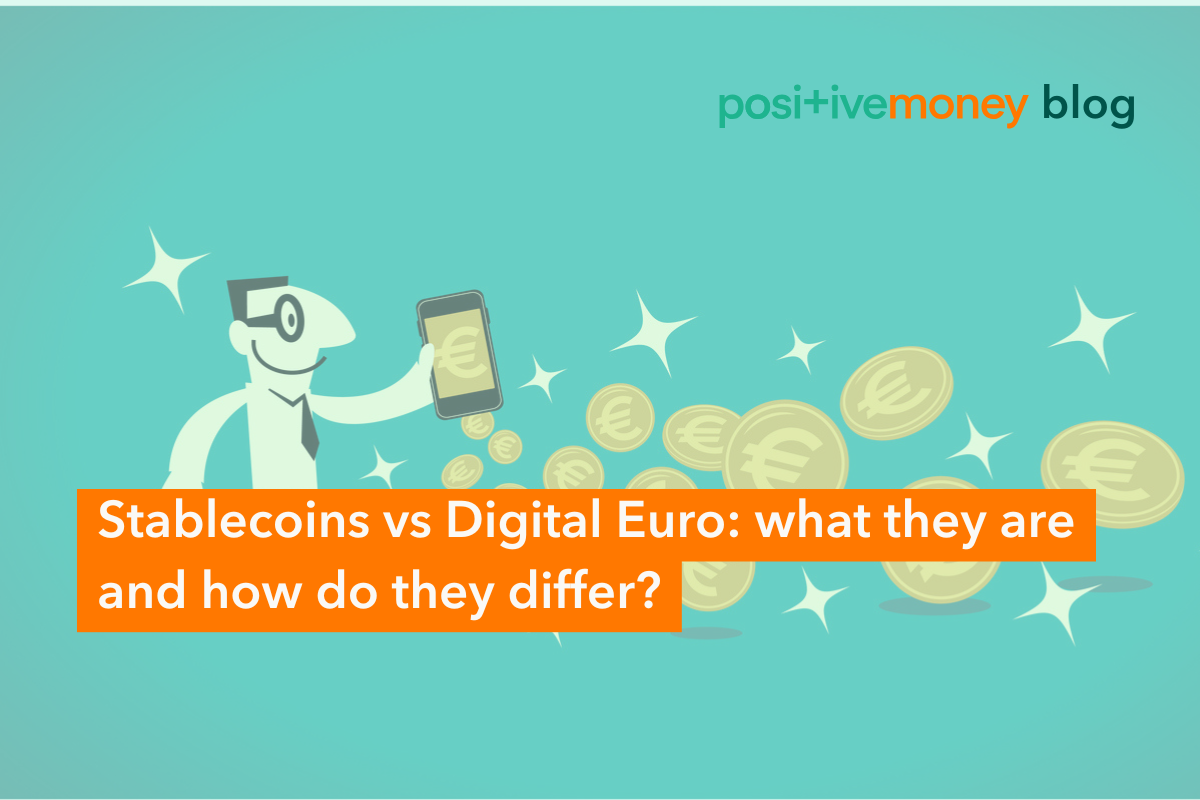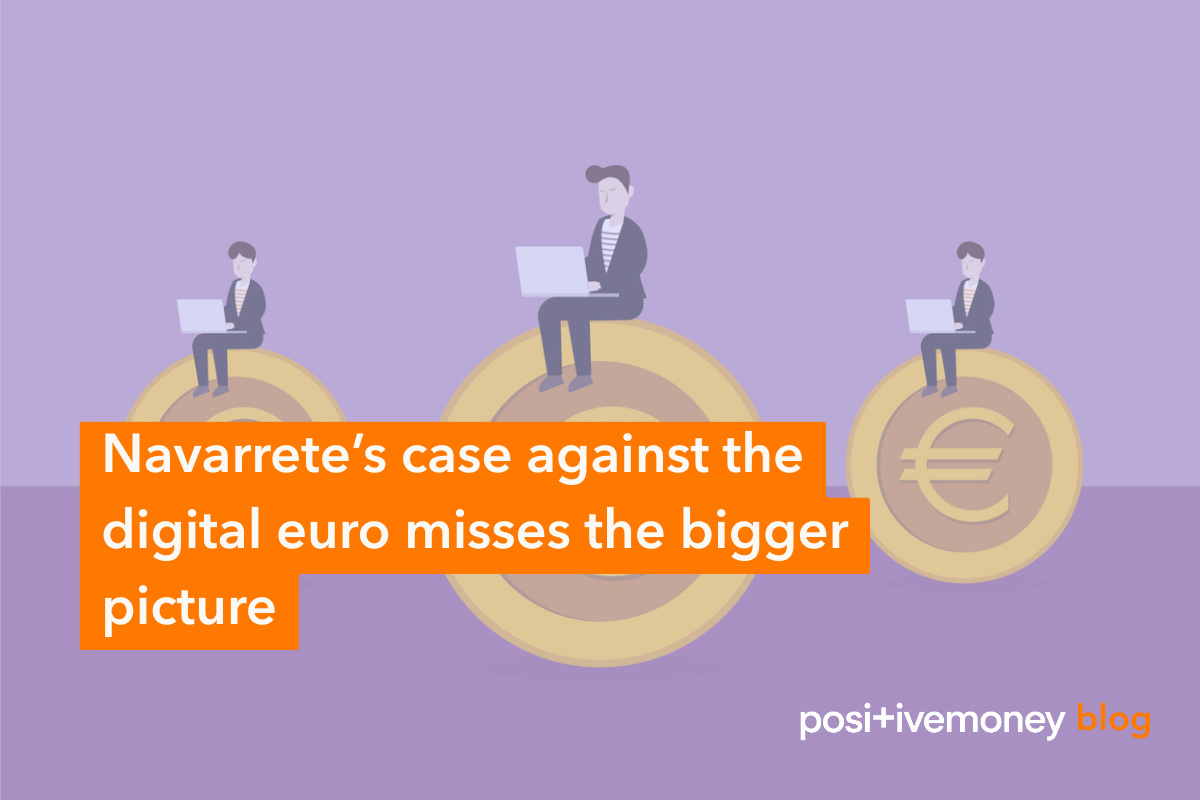
The future of moneyEU
29 October 2025
This blog expands on our recent EU Observer article, unpacking why a digital euro is key for financial inclusion and resilience in Europe—offering a broader perspective that starts from the recent debate led by MEP Fernando Navarrete.
Europe’s decision on the digital euro is about the kind of society we want to build, and the values we want it to rest on. These kinds of decisions require balanced public debate. This is why it is so troubling that Fernando Navarrete (EPP/ES), the European Parliament’s rapporteur on the digital euro, presents his recent article ‘Do we really need the digital euro: a solution to which problem exactly?’ as a “rational common ground to assess the proposal” and “as free as possible of predetermined position”. Yet from the outset, opening with the question “Why are we discussing something citizens are not asking for?”, his contribution is not neutral. His approach reflects a fear of transition: warning of financial instability, lost innovation, and privacy risks, while ignoring the costs of maintaining the status quo and the bigger geopolitical context. He also disregards the numerous calls by civil society, academics and research institutions for digital public money since the 2008 financial crisis. A digital euro would give people universal access to safe electronic money, strengthen financial resilience, and deliver lower prices and better services.
As with any political debate, arguments are informed by different perspectives on what kind of society we want. What underpins Navarrete’s position is the assumption that we live in a purely competitive market economy, which informs his views about what role the state should play in the economy. He believes that any state interference “must be justified by a clear market failure that private actors are unable to resolve”. In other words, markets are better equipped to meet our social needs, and state intervention should be minimal. However, Article 3(3) of the Treaty on European Union commits to a highly competitive social market economy. This wording, introduced with the Lisbon Treaty in 2009, codifies the settlement that had long defined European economies: markets are powerful engines of wealth creation, but the state has a duty to ensure social cohesion and that essential goods and services are universally accessible. By writing ‘social’ into the EU’s economic foundations, the Treaty recognised that Europe’s economy is not ‘markets first’ but ‘markets embedded within a social contract’. We strongly believe that money and payment systems are essential public goods, without which society as we know it would cease to function.
To understand the potential of the digital euro, the difference between the two types of money is key. Cash, created by central banks, is public money. Bank deposits, by contrast, are private money, and are created by commercial banks when they issue loans. They are a claim on the bank to make payments on your behalf and give you cash if you ask for it. This distinction matters: if a bank fails, its deposits are at risk, while cash remains safe.
In the last decades, bank deposits have become increasingly dominant. Today, more than 85% of the money in circulation is private bank money. Contrary to what Navarrete claims in his article, the decline of cash does not solely come from increasing demands for digital payments, but also banks closing ‘unprofitable’ branches and ATMs. Without the digital euro, Europeans could become entirely dependent on private money and private payment infrastructures, which is not without its risks as we have seen with the numerous banking crises of the last centuries.
The reliance on banks to provide access to the public goods of money and payment systems also causes exclusion: 8% of Eurozone residents lack a payment card, and around one-fifth lack either a card or a payment account, with higher rates among lower-income groups.
In a competitive social market economy, it is the role of the state to ensure that people have continued access to safe public money and payment systems in the digital age. A digital euro will ensure inclusion and strengthen resilience.
In his article, Navarrete parrots the banking lobby’s claim that a digital euro will lead to an outflux of bank deposits (aka a bank run) towards digital euros, which in turn will impact the banks’ ability to lend to the real economy and cause widespread financial instability. But he ignores research showing the risk is low or that CBDCs could even reduce risks by giving policymakers real-time data to shore up weak banks early, lowering the incentive to run.
To appease banks, the ECB gradually diluted the digital euro’s ambition restricting its use mainly to payments not saving. Interest payments are excluded, and there will be limits on the amount of digital euros a person can hold. In her analysis of the digital euro’s early development, Sereina Grünewald observes that the ECB shifted its objective from creating a “digital equivalent of euro banknotes” to an “electronic means of payment for retail payments”. Regrettably, in doing so, the ECB undercut its own case for the digital euro, weakening the strongest argument for public uptake: that it would serve as a safe, state-backed equivalent to bank deposits, just as cash has always been. But these limits are a political choice. Gradually raising holding limits could strengthen financial resilience in the long run without destabilising banks.
Unlike the ECB, Navarrete is an elected representative whose duty is to weigh society’s broader interests. Yet, since taking office in July 2024, 77% of Navarrete’s meetings on the digital euro have been with the private payment industry and banks, and he has had only one meeting with an NGO.
Navarrete also argues that the digital euro would undermine competition. But Europe’s banking sector is already plagued by insufficient competition, high prices, and poor service.
Because of the inherent fragility of bank deposits, governments have churned out thousands of pages of banking regulation and numerous privileges and protections that allow banks and their money to exist. Examples are deposit guarantee schemes, access to lenders of last resort, and banking licenses. In our current monetary architecture, these rules and protections are essential to prevent systemic financial crises. However, they have led to an uneven playing field for payments and financial services and high barriers to entry for competitors, resulting in oligopolistic market structures in many European countries. In 2024, the Dutch authority for consumers and markets revealed that the Dutch savings market has features of a silent cartel.
The lack of competition in the banking sector was starkly revealed during the ECB’s recent interest rate hikes to counter inflation after 2022. While banks earned more than €100 billion annually on their deposits with the central bank, they passed far less on to savers. In Belgium, public frustration with this mismatch led the government to issue a special one-year state bond offering higher returns than the banks, in an attempt to pressure them into raising deposit rates. The initiative briefly jolted the sector, but it failed to bring about lasting competitive change.
The digital euro offers a historic opportunity to cure the European banking sector of its plague of insufficient competition. This can be done through a gradual implementation, one that would allow people to gradually hold more digital euros. This will give banks time to manage bank deposit outflows and to adjust their business models.
Navarrete claims that a digital euro would crowd out private initiatives, and centralise payments in a single public ledger. But this is a misrepresentation of what is actually on the table. The ECB has been explicit that the digital euro will follow the two-tier model: it will be issued by the central bank but distributed by banks and payment providers, who will remain responsible for KYC, fraud prevention, customer interfaces and innovation. Far from disintermediating the private sector, the ECB has established a Digital Euro Innovation Platform with around 70 market participants to co-develop services and use cases. The proposed legal-tender status of the digital euro simply guarantees universal acceptance, as with cash today; it does not exclude other payment instruments, and even encourages innovation on top of the digital euro ledger.
By providing a trusted public anchor, lower barriers to entry, and open standards, the digital euro could give European payment providers, including non-bank financial institutions, the scale and level playing field they need to compete with Visa, Mastercard, and Big Tech. This will lead to more competition, and in the end better services and lower prices for people and businesses.
Navarrete acknowledges that trust in public institutions is essential for a digital euro to succeed, yet tries to erode that very trust by evoking surveillance scenarios popular in conspiracy circles. The irony is that his alternative leaves people’s data with corporations that monetise it. Privacy matters, but the ECB has repeatedly said it has no interest in holding personal data or direct customer relationships. The ECB already processes limited data through its existing settlement systems (TARGET2 and TIPS), and under a digital euro it would continue to see only a minimal, pseudonymised dataset for this purpose - never people’s identities or what they spend their money on.
The ECB has even proposed going further than the European Commission’s proposal on the digital euro: cash-like anonymity for offline use and stronger privacy for low-value online payments. As rapporteur, Navarrete could help ensure that high privacy safeguards are enshrined in the final law and design of the digital euro.
In the end, Navarrete’s analysis is less a “rational common ground” than a fearful defence of the status quo. He warns of financial instability without acknowledging that the digital euro could strengthen resilience, especially in the long run; he decries disruption to competition while ignoring the banking sector’s entrenched oligopoly; and he raises alarmist privacy concerns while ignoring his responsibility as a lawmaker and rapporteur to ensure that those concerns are addressed in the final design of the digital euro.
Navarrete writes: “I am personally not eager to be part of the transitional generation, and I presume that is the case for most EU citizens.” However, the very developments that he highlights in the opening of his article - crisis in the monetary and financial order, the erosion of trust, and the rise of alternative visions of money - not to mention the recent popularity of populist politicians, all prove that people are willing to upheave systems that they do not feel are serving them. Civil society and academics have long argued for digital public money precisely because the status quo is not good enough. The digital euro is an opportunity to embrace transition, and build a better, more inclusive and resilient monetary and financial system.
Written by Laura Casonato (Head of Policy at Positive Money EU), Vicky Van Eyck (former executive director of Positive Money EU and digital euro policy expert), Dr Martijn Jeroen van der Linden (professor of practice in new finance at The Hague University of Applied Science)
